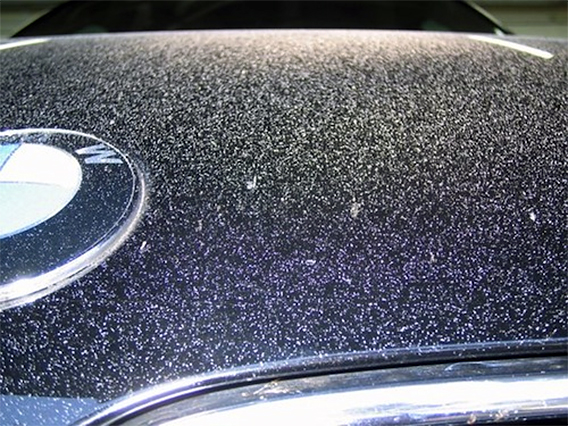WHAT IS OVER-SPRAY?
While there is probably not one single definition for the term overspray, this will encompass most situations: Overspray refers to the application of any form of paint, varnish, stain, or other non-water-soluble airborne particulate material onto an unintended location. The way we explain it to customers is, "Anything that has embedded/stuck onto the car paint (most likely synthetic) that has created a strong bond which requires removal beyond washing, and/or clay barring the paint." While this is our fancy definition, a simpler way to put it is this, "stuff like spray paint, or other chemicals that get blown onto your car, and stick to the paint to the point where it requires professional removal (by a detailer like us). Most situations that we’ve run into with overspray have happened in places like apartment complexes where the buildings are being repainted, and the wind carries the paint that is being sprayed on the building over to your car, and the result is a car that looks like it has freckles of paint all over it. Of course, this is only one way for overspray to happen, and it does not have to be actual paint. Really, overspray could just be some unknown material that is on your car that you want off!
HOW DO we REMOVE OVER-SPRAY?
In most cases, overspray must be removed through polishing. For more details on what polishing is, visit the "information" tab or click "Polishing." The reason for this is overspray, in most cases is a chemical that tends to bond very strongly to the car paint, it takes a more aggressive measure to remove it. There are times when overspray is much more simple and can be removed through less intense means, however, in most cases, polishing is the most efficient and effective way to remove it.
PROBLEM AREAS WITH OVER-SPRAY
While removing overspray from the paint is fairly simple, though time-consuming, removing it from other areas can prove to be more difficult. Some of those areas include felt-like fabric on wheel wells, black plastic trim, rubber gasket trim, backsides of side-view mirrors, and sometimes more. The reason these areas can be difficult is that they are sometimes areas that cannot be polished, and as we’ve stated before, some overspray is so strong, that even the strongest adhesive removers do not help. It is important to manage your own expectations when it comes to these problem areas, and understand that in some cases these areas simply cannot be perfected, and perfection should not be the expectation. It is also important to note that in many cases, these areas will improve themselves over time. The overspray will degrade more and more and may be able to be addressed in a easier way after some of that has occurred.
